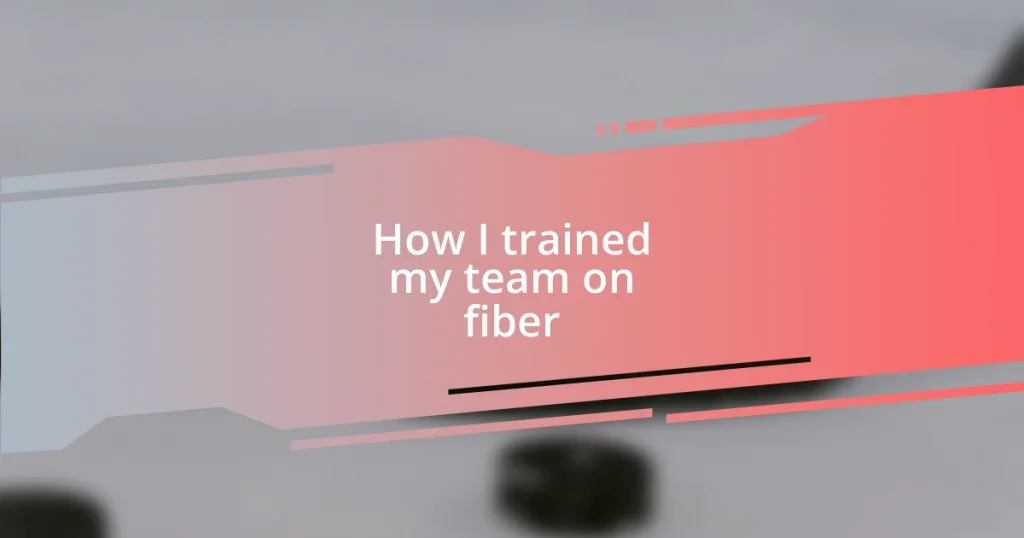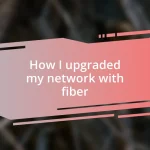Key takeaways:
- Identifying individual strengths and gaps is essential for personalizing training, transforming it into a more effective experience for team members.
- Hands-on training sessions significantly enhance comprehension and engagement, making learning more practical and relatable through real-world applications.
- Ongoing support and regular feedback foster a collaborative learning environment, encouraging continuous growth and deeper understanding among team members.

Understanding fiber training needs
When I first assessed my team’s knowledge about fiber, I realized just how varied their understanding was. Some team members had a solid grasp of fiber types, while others were lost in the intricacies of applications and benefits. Have you ever been in a situation where you thought everyone was on the same page, only to discover different levels of insight? It’s a bit unsettling but also a wake-up call.
I found that identifying individual strengths and gaps was crucial for tailoring the training. For instance, I remember working with a teammate who had a background in textiles but struggled with technical specifications. This really highlighted the importance of personalizing training; one-size-fits-all definitely doesn’t apply in such a detailed field. Engaging with each person’s unique experiences can transform the training into something truly effective.
Another revelation came when I realized the emotional connection my team had with their work. I noticed that those who felt more invested naturally absorbed the material better. This led me to wonder—how can we tap into that passion? By fostering an environment where questions are welcomed and discussions are encouraged, I saw my team not only learning but also genuinely enjoying the process. Isn’t it incredible how understanding training needs can lead to both growth and camaraderie?

Developing a comprehensive training plan
Developing a comprehensive training plan requires a thoughtful approach. I began by setting clear objectives based on each team member’s existing knowledge and the specific skills needed for fiber expertise. For example, when I created a module focused on fiber applications, I included case studies from past projects to illustrate real-world relevance. Have you ever noticed how practical examples can bring learning to life? It’s astonishing how much more relatable a concept becomes when linked to tangible experiences.
To ensure maximum engagement, I incorporated a mix of training formats—workshops, hands-on sessions, and even online resources. I remember hosting an interactive workshop where team members could experiment with different fiber materials. The energy in the room was palpable, with everyone eagerly discussing what they learned by experimenting. I couldn’t help but smile seeing the excitement; it reaffirmed my belief that learning through doing is profoundly impactful.
Lastly, I introduced regular feedback sessions to keep the training plan adaptable. Initially, I felt hesitant, thinking my team would be too busy or uninterested to provide input. But I was pleasantly surprised; their feedback was invaluable, helping me adjust content and pacing. This collaborative approach not only refined the training but also created a sense of ownership among team members, fostering a deeper commitment to their learning journey.
| Training Element | Description |
|---|---|
| Objectives | Set clear goals tailored to team member knowledge levels. |
| Formats | Utilize diverse methods like workshops and hands-on sessions. |
| Feedback | Incorporate regular feedback to adapt the training plan. |

Implementing hands-on training sessions
Implementing hands-on training sessions was a game-changer for my team. I recall the first time we worked with fiber samples; it felt less like a lesson and more like an exploration. My teammates engaged with enthusiasm, their curiosity igniting conversations I hadn’t anticipated. That day, I realized that letting them physically interact with the fibers dramatically enhanced their understanding. It’s amazing how touching the material deepens comprehension—seeing the fibers in action brought the theoretical to life.
To maximize the effectiveness of these hands-on sessions, I made sure to create an environment conducive to exploration. Here’s what I focused on:
- Diverse Activities: Incorporating various hands-on activities like fiber identification games and material testing.
- Group Collaborations: Encouraging team members to work together, fostering a sense of camaraderie and shared learning experiences.
- Real-World Applications: Designing tasks that mirrored actual project scenarios, making the learning truly relevant.
Each of these elements not only enriched the training but also fostered a deeper connection to the material. I’ve seen firsthand how engaging actively can turn a surface-level understanding into a well-rounded expertise.

Assessing team knowledge on fiber
Assessing the team’s knowledge on fiber was crucial before diving into our training program. I conducted a survey to gauge their existing expertise, and I was surprised by the varying levels of familiarity with fiber concepts. Some team members were well-versed, while others were just beginning to explore this fascinating subject. It reminded me of the diverse backgrounds that everyone brings to the table, and how that can shape our conversations.
During a follow-up meeting, I facilitated a discussion where team members could share what they knew—and didn’t know—about fiber. I still remember a particularly enlightening moment when one colleague, who initially felt overwhelmed, shared their misconceptions about fiber types. It served as a valuable reminder that fostering an open environment encourages vulnerability, making it easier for everyone to participate without fear of judgment. I often wonder, how can we truly learn if we don’t start by admitting what we don’t yet grasp?
To further assess their understanding, I organized a quick quiz that incorporated real-life scenarios involving fiber. I was amazed at the responses! It wasn’t just about correct answers; the lively discussions that erupted among team members showed how invested they were in not only their learning but also in supporting each other. This experience underscored that assessing knowledge isn’t just a measurement tool—it’s an opportunity to cultivate engagement and collaboration among team members, enhancing the overall learning process.

Providing ongoing support and resources
Ongoing support is vital in training, especially with something as intricate as fiber. I remember the initial days post-training when team members came to me with questions that arose only after they attempted to apply what they learned. This experience made me realize how providing accessible resources, like a comprehensive online library or quick reference guides, could bridge that gap. I encouraged my team to lean on these resources whenever they felt stuck, fostering a culture of self-guided learning and empowerment.
Alongside resources, I started regular check-in sessions, creating a space where everyone could discuss challenges and share insights. One day, a member approached me with a fiber confusion that had been bothering them; they were struggling to differentiate between similar fibers. In that moment, it was gratifying to see how a few shared experiences and a simple group discussion dismantled their uncertainty. Couldn’t this approach, I thought, be the key to really solidifying their understanding? These open dialogues transformed our team into a collaborative learning community, where feedback flowed freely, igniting deeper explorations of the material.
To keep the momentum, I also fostered a mentorship program within the team. Pairing experienced members with those still finding their footing not only reinforced knowledge but also strengthened team bonds. I’ll never forget the camaraderie that flourished from these pairings—a senior member guiding a novice through the nuances of fiber properties became a beautiful testament to our collective growth. Isn’t it fascinating how knowledge shared can create a ripple effect of understanding across the team?

Evaluating training effectiveness and feedback
When evaluating the effectiveness of our training, I found that feedback was invaluable. One particularly revealing session involved gathering anonymous surveys post-training, which allowed team members to express their thoughts candidly. It felt like peeling back layers—some praised the content’s clarity, while others indicated they wished for more hands-on examples. Listening to these insights taught me that constructive feedback guides continuous improvement.
During one of our team meetings, I opened the floor for direct conversations about the training experience. I still recall the nervous energy in the room as team members began to speak up. One colleague shared how a specific part of the training resonated with them on a deeper level, igniting a passion for fiber they hadn’t realized was there. This moment reminded me how powerful feedback can be—not just for assessing effectiveness, but also for fostering genuine enthusiasm.
I initiated follow-up quizzes to assess knowledge retention, and the outcomes were both surprising and enlightening. A few members flaunted newfound confidence, tackling complex concepts they once felt lost on, while others noticed gaps in their understanding despite their initial confidence. It made me consider—how can we turn this awareness into action? These reflections have shown me that training is a continuing journey, where feedback and evaluation transform dates on a calendar into meaningful, growth-oriented experiences.















